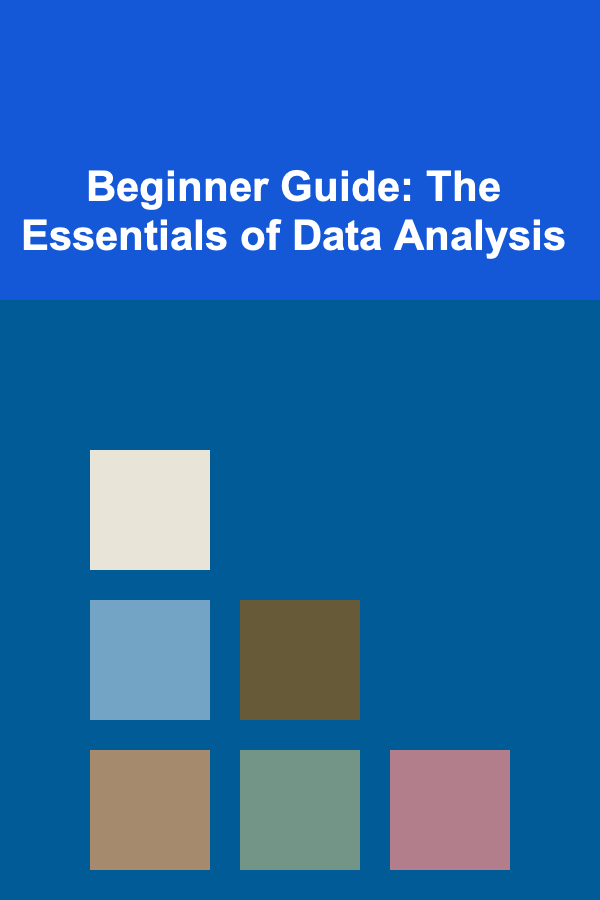
Beginner Guide: The Essentials of Data Analysis
ebook include PDF & Audio bundle (Micro Guide)
$12.99$9.99
Limited Time Offer! Order within the next:

Data analysis is a powerful skill in today's world, driving decision-making processes across various industries. Whether you're working in business, healthcare, technology, or social sciences, understanding the fundamentals of data analysis can help you uncover insights, optimize processes, and make informed decisions. This beginner guide covers the essential concepts, tools, and techniques you need to get started with data analysis.
Understanding Data Analysis
At its core, data analysis is the process of inspecting, cleaning, transforming, and modeling data to discover useful information, draw conclusions, and support decision-making. It involves examining data in various ways to extract insights and patterns that were not immediately obvious.
Data analysis can be categorized into several stages, each serving a distinct purpose in the process:
- Data Collection: Gathering raw data from various sources.
- Data Cleaning: Preparing the data for analysis by correcting errors and handling missing values.
- Data Exploration and Visualization: Summarizing and visualizing data to identify patterns and trends.
- Data Modeling: Applying statistical methods or machine learning techniques to derive meaningful insights.
- Interpretation and Decision Making: Drawing conclusions and making decisions based on the analysis.
Key Concepts in Data Analysis
Before diving into the technical tools and techniques, it's important to understand a few key concepts that underpin data analysis.
Types of Data
Data can be classified into different types based on its nature and structure. Understanding these distinctions will help you choose the right analysis methods:
-
Qualitative (Categorical) Data: Data that represents categories or groups, such as names, colors, or yes/no responses. Examples include gender, nationality, or product type.
-
Quantitative (Numerical) Data: Data that represents measurable quantities. This can be further divided into:
- Discrete Data: Data that can take specific, distinct values (e.g., number of children, count of products sold).
- Continuous Data: Data that can take any value within a range (e.g., height, weight, temperature).
Descriptive vs. Inferential Statistics
-
Descriptive Statistics: These are methods used to summarize and describe the main features of a dataset. Common techniques include:
- Measures of central tendency (mean, median, mode)
- Measures of dispersion (variance, standard deviation, range)
- Frequency distributions and percentiles
-
Inferential Statistics: These methods allow you to make predictions or inferences about a population based on a sample. Common techniques include hypothesis testing, confidence intervals, and regression analysis.
Data Bias and Ethics
Data analysis is not just about crunching numbers; it's also about ensuring that the data you're analyzing is reliable, valid, and ethically sourced. Bias in data collection, sampling, or analysis can lead to misleading conclusions. Always ask:
- Is the data representative of the population you're analyzing?
- Are there any biases in how the data was collected or processed?
- Are you respecting privacy and confidentiality when handling sensitive data?
Essential Tools for Data Analysis
To effectively perform data analysis, you need to become familiar with a variety of tools. While there are numerous software options available, here are the most commonly used tools in the field:
1. Excel (or Google Sheets)
For beginners, Microsoft Excel is an excellent starting point. It's widely accessible and offers a range of basic tools to perform data analysis, such as:
- Pivot tables for summarizing data
- Charts and graphs for visualizing data
- Statistical functions like mean, median, standard deviation, etc.
- Data filtering and sorting for easier analysis
While Excel may not be as powerful as other tools for handling very large datasets, it's an easy way to get started with small to medium-sized datasets.
2. R Programming
R is an open-source programming language specifically designed for statistical analysis and data visualization. It's a great tool for more advanced analysis, especially in research, academia, and specialized fields. R offers a wealth of libraries for data manipulation, statistical modeling, and visualization, such as ggplot2 for data visualization, and dplyr for data manipulation.
Some key advantages of R include:
- Powerful for statistical analysis
- Wide range of packages for specific analysis types
- Excellent visualization capabilities
3. Python
Python is one of the most popular programming languages for data analysis due to its versatility and large ecosystem of libraries. The key libraries in Python for data analysis include:
- Pandas: For data manipulation and cleaning
- NumPy: For numerical data and matrix operations
- Matplotlib and Seaborn: For data visualization
- SciPy: For scientific and technical computing
- Scikit-learn: For machine learning algorithms
Python is widely used across various industries due to its ease of use, readability, and scalability.
4. SQL (Structured Query Language)
SQL is a domain-specific language used for managing and querying relational databases. It's essential for anyone working with large datasets stored in databases. SQL allows you to:
- Retrieve specific data using
SELECTstatements - Filter data with
WHEREclauses - Aggregate data with functions like
SUM(),COUNT(),AVG() - Join tables and perform complex queries
SQL is particularly useful when working with structured data stored in databases like MySQL, PostgreSQL, or SQL Server.
The Data Analysis Process
Now that we've covered the basics, let's dive into the step-by-step process of conducting data analysis.
Step 1: Define the Problem
Before you begin analyzing data, clearly define the problem you are trying to solve. This will guide your entire analysis process and help you determine which data is relevant.
- What question are you trying to answer?
- What hypotheses do you have?
- What data do you need to collect, and where will it come from?
For example, if you are analyzing sales data for an e-commerce business, you might want to understand factors that influence customer purchasing behavior, such as time of year, product type, or customer demographics.
Step 2: Collect and Clean the Data
Data collection can come from a variety of sources, including surveys, business systems, sensors, or public datasets. Once you have the data, the next step is cleaning and preparing it for analysis.
Data cleaning involves:
- Handling missing values (imputing, deleting, or flagging them)
- Removing duplicates
- Fixing inconsistent or incorrect data (e.g., spelling errors, wrong data types)
- Normalizing or transforming data if necessary (e.g., converting text to lowercase, or scaling numerical values)
This step is crucial because poor data quality will lead to inaccurate analysis and misleading results.
Step 3: Explore and Visualize the Data
Once your data is clean, the next step is to explore and visualize it. Data exploration involves looking for patterns, trends, and relationships in the data. Common techniques include:
- Descriptive statistics: Calculate measures like mean, median, standard deviation, etc.
- Visualizations: Create graphs like histograms, box plots, scatter plots, and line charts to help visualize the data.
Data visualization is particularly powerful for identifying outliers, trends over time, and relationships between variables. For example, you might visualize sales data by product category or demographic group to understand which factors drive higher sales.
Step 4: Apply Statistical Models
In this step, you apply more advanced statistical techniques to answer specific questions or test hypotheses. This could involve:
- Regression analysis: To understand relationships between variables and make predictions.
- Hypothesis testing: To test assumptions and determine if the results are statistically significant.
- Clustering or classification: If you're dealing with large datasets, machine learning techniques can help group similar data points or predict outcomes.
For example, if you are trying to predict future sales, you might use regression analysis to understand how different factors (e.g., marketing spend, seasonality) influence sales.
Step 5: Interpret Results and Make Decisions
After applying statistical models, interpret the results to draw meaningful conclusions. This is the final step where you tie the analysis back to the original business problem or research question. You should be able to:
- Explain the findings in simple terms
- Make recommendations based on the analysis
- Identify potential limitations or areas for further investigation
For example, if your analysis showed that certain products sell better during specific months, you might recommend focusing marketing efforts during peak seasons.
Conclusion
Data analysis is a critical skill that allows individuals and organizations to make data-driven decisions. By understanding the fundamental concepts of data, getting familiar with essential tools, and following the step-by-step process of data analysis, beginners can start unlocking insights and improving outcomes.
Whether you're analyzing sales data, customer behavior, or any other type of information, these essential skills will empower you to solve problems and drive positive change. As you gain more experience, you'll refine your ability to use advanced techniques and tools to tackle even more complex challenges. Happy analyzing!
Reading More From Our Other Websites
- [Biking 101] How to Choose the Best Bike Pedals for Your Riding Style
- [Beachcombing Tip 101] 10 Essential Tips for Beginner Shell Collectors: From Beach Walks to Storage
- [Home Security 101] How to Make Your Home Safer with Motion Detectors: A Step-by-Step Guide
- [Organization Tip 101] How to Organize Your Home Security Records
- [Organization Tip 101] How to Use Open Shelving for Stylish Organization
- [Home Party Planning 101] How to Build a Killer Party Playlist for a Good Vibe: Genre, Flow, and Avoiding the Awkward Silence
- [Gardening 101] Eco‑Friendly Garden Edging: Sustainable Options for Green Gardens
- [Star Gazing Tip 101] Myths Written in Constellations: Storytelling Through the Heavens in Antiquity
- [Organization Tip 101] How to Create a Weekly Meal Planning System
- [Tiny Home Living Tip 101] How to Furnish a Tiny Home Living Room with Multi‑Purpose Pieces

How to Build a Checklist for Setting Up Event Decorations and Branding
Read More
How to Maintain Your Home's Flooring Based on Material Type
Read More
How to Set Financial Goals and Stay on Track
Read More
How to Use Lighting to Make Your Home More Sustainable
Read More
10 Tips for Staying Inspired and Avoiding Burnout with Your Artist Planner
Read More
10 Tips for a Reptile Health Monitoring Checklist
Read MoreOther Products

How to Build a Checklist for Setting Up Event Decorations and Branding
Read More
How to Maintain Your Home's Flooring Based on Material Type
Read More
How to Set Financial Goals and Stay on Track
Read More
How to Use Lighting to Make Your Home More Sustainable
Read More
10 Tips for Staying Inspired and Avoiding Burnout with Your Artist Planner
Read More